
Varna Monastery is a large preserved early medieval monastery complex, opened near Varna, Bulgaria, with the status of a cultural monument of national importance for Bulgaria since 2015. [1]

Varna Monastery is a large preserved early medieval monastery complex, opened near Varna, Bulgaria, with the status of a cultural monument of national importance for Bulgaria since 2015. [1]
Varna Monastery, the Royal Monastery of the Holy Mother of God - Varna, dates from the 9th century and probably as the Ravna Monastery was burnt by the Pechenegs during the invasions of the Bulgarian Lands in the 11th century, and according to other sources, it existed until the 18th century or until the beginning of the Bulgarian Revival. [2]
Found by Karel Shkorpil in 1921 on the Franga Plateau just above the city itself. Located in the most appropriate location on the plateau with view and water source.
Studied in detail from 1996 until today by students in the specialty "archeology" at the Veliko Tarnovo University, as well as from the UK, Russia, Germany and Italy.
A cathedral church, a chapel tower, a huge scriptorium, a library, a school, a monastic dormitory, a holy shrine were found, and among the finds are an altar table, a blacksmith's workshop and coins – Bulgarian, Raška, Venetian, Byzantine, Ottoman. The buildings are filled with a magnum opus, which construction equipment is used mainly for representative buildings, for example, the Great Basilica, Pliska.
In the area of the monastery was found the seal of Boris I of Bulgaria, two lead seals of Tsar Simeon the Great and the seal of Tsar Peter I of Bulgaria.
The Varna Monastery and the Ravna Monastery are considered the most significant literary centers of the Preslav Literary School outside the capitals Pliska and Preslav. The patron of the monastery is the Mother of God, who is also the patron saint of the city of Varna.
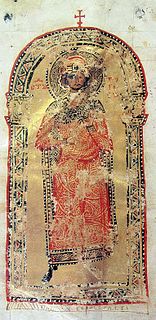
Boris I, also known as Boris-Mihail (Michael) and Bogoris, was the ruler of the First Bulgarian Empire in 852–889. At the time of his baptism in 864, Boris was named Michael after his godfather, Emperor Michael III. The historian Steven Runciman called him one of the greatest persons in history.

Saint Naum, also known as Naum of Ohrid or Naum of Preslav was a medieval Bulgarian writer, enlightener, one of the Seven Apostles of the First Bulgarian Empire and missionary among the Slavs. He was among the disciples of Saints Cyril and Methodius and is associated with the creation of the Glagolitic and Cyrillic script. Naum was among the founders of the Pliska Literary School. Afterwards Naum worked at the Ohrid Literary School. He was among the first saints declared by the Bulgarian Orthodox Church after its foundation in the 9th century. The mission of Saint Naum played significant role by transformation of the local Slavs into Bulgarians.

The Preslav Literary School, also known as the '''Pliska Literary School''' or '''Pliska-Preslav Literary school''' was the first literary school in the medieval Bulgarian Empire. It was established by Boris I in 886 in Bulgaria's capital, Pliska. In 893, Simeon I moved the seat of the school from the First Bulgarian capital Pliska to the new capital, Preslav. Preslav was captured and burnt by the Byzantine Emperor John I Tzimisces in the year 972 in the aftermath of Sviatoslav's invasion of Bulgaria.
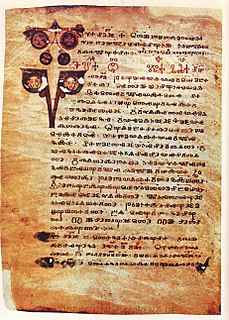
The Ohrid Literary School or Ohrid-Devol Literary school was one of the two major cultural centres of the First Bulgarian Empire, along with the Preslav Literary School. The school was established in Ohrid. Another center was Devol as well as Drembica, Glavinica and Velika with unknown location. All the school centers were located in a then Bulgarian province known as Kutmichevitsa. It was founded in 886 by Saint Clement of Ohrid on the order of Boris I of Bulgaria simultaneously or shortly after the establishment of the Preslav Literary School. After Clement was ordained bishop of Drembica, Velika (bishopric) in 893, the position of head of the school was assumed by Naum of Preslav. The Ohrid Literary School used the Glagolitic alphabet from its establishment until the 12th century and Cyrillic from the end of the 9th century onward. Between 990 and 1015, Ohrid was the capital of the Bulgarian Empire and simultaneously also the seat of the Bulgarian Patriarchate.
Constantine of Preslav was a medieval Bulgarian scholar, writer and translator, one of the most important men of letters working at the Preslav Literary School at the end of the 9th and the beginning of the 10th century. Biographical evidence about his life is scarce but he is believed to have been a disciple of Saint Methodius. After the saint's death in 885, Constantine was jailed by the Germanic clergy in Great Moravia and sold as slave in Venice. He escaped to Constantinople, moving to Bulgaria around 886 and working at the Preslav Literary School.

The Bulgarian Orthodox Church, legally the Patriarchate of Bulgaria, is an autocephalous Orthodox jurisdiction. It is the oldest Slavic Orthodox church, with some 6 million members in Bulgaria and between 1.5 and 2 million members in a number of European countries, the Americas, Australia, New Zealand and Asia. It was recognized as autocephalous in 1945 by the Ecumenical Patriarchate of Constantinople.

The modern Veliki Preslav or Great Preslav, former Preslav, is a city and the seat of government of the Veliki Preslav Municipality, which in turn is part of Shumen Province. Veliki Preslav is situated at an altitude of 132 m.

Pliska was the first capital of the First Bulgarian Empire during the Middle Ages and is now a small town in Shumen Province, on the Ludogorie plateau of the Danubian Plain, 20 km northeast of the provincial capital, Shumen.
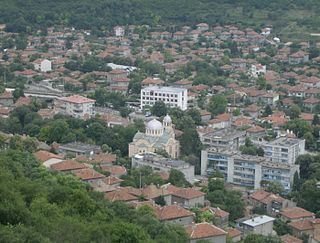
Provadia is a town in northeastern Bulgaria, part of Varna Province, located in a deep karst gorge along the Provadiya River not far from the Bulgarian Black Sea Coast. It is the administrative centre of Provadia Municipality. As of December 2009, the town has a population of 12,901 inhabitants.
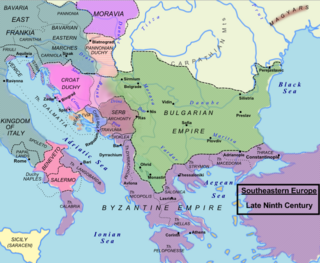
The First Bulgarian Empire was a medieval Bulgar-Slavic and later Bulgarian state that existed in Southeastern Europe between the 7th and 11th centuries AD. It was founded in 680–681 after part of the Bulgars, led by Asparuh, moved south to the northeastern Balkans. There they secured Byzantine recognition of their right to settle south of the Danube by defeating – possibly with the help of local South Slavic tribes – the Byzantine army led by Constantine IV. During the 9th and 10th century, Bulgaria at the height of its power spread from the Danube Bend to the Black Sea and from the Dnieper River to the Adriatic Sea and became an important power in the region competing with the Byzantine Empire. It became the foremost cultural and spiritual centre of south Slavic Europe throughout most of the Middle Ages.

The Civil Script or, colloquially, the Russian Cyrillic, is a modification of the Cyrillic script introduced by the Russian Tsar Peter the Great in the period from 1708 to 1710. The aim was to alter the appearance of Russian, making it more similar to Western European writing of that time.

The medieval Bulgarian royal charters are some of the few surviving secular documents of the Second Bulgarian Empire, and were issued by five tsars roughly between 1230 and 1380. The charters are written in Middle Bulgarian using the Early Cyrillic alphabet.

Dragalevtsi Monastery of the Holy Mother of God of Vitosha is a Bulgarian Orthodox monastery on the lower slopes of Vitosha mountain on the outskirts of the capital Sofia in western Bulgaria. Founded in the mid-14th century by Bulgarian tsar Ivan Alexander, the monastery was abandoned after the Ottoman conquest of Sofia and reestablished in the late 15th century, when it became an important literary centre. The monastery church and some of its frescoes date from this period.

Karel Václav Škorpil was a Czech-Bulgarian archaeologist and museum worker credited along with his brother Hermann with the establishment of those two disciplines in Bulgaria.
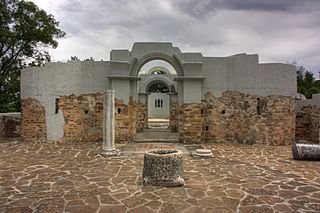
The Round Church, also known as the Golden Church or the Church of St John, is a large partially preserved early medieval Eastern Orthodox church. It lies in Preslav, the former capital of the First Bulgarian Empire, today a town in northeastern Bulgaria. The church dates to the early 10th century, the time of Tsar Simeon I's rule, and was unearthed and first archaeologically examined in 1927–1928.
Saint Clement of Ohrid was one of the first medieval Bulgarian saints, scholar, writer and enlightener of the Slavs. He was one of the most prominent disciples of Saints Cyril and Methodius and is often associated with the creation of the Glagolitic and Cyrillic scripts, especially their popularisation among Christianised Slavs. He was the founder of the Ohrid Literary School and is regarded as a patron of education and language by some Slavic people. He is considered to be the first bishop of the Bulgarian Orthodox Church, one of the Seven Apostles of Bulgarian Orthodox Church and one of the premier saints of modern Bulgaria. The mission of Saint Clement was the crucial factor which transformed the Slavs in Macedonia into Bulgarians. Saint Clement is also the patron saint of North Macedonia, the city of Ohrid and the Macedonian Orthodox Church.
The People's Council of Preslav took place in 893. It was among the most important events in the history of the First Bulgarian Empire and was a cornerstone of the Christianization of Bulgaria under prince Boris I.
This is a list of people, places, and events related to the medieval Bulgarian Empires — the First Bulgarian Empire (681–1018), and the Second Bulgarian Empire (1185–1396).
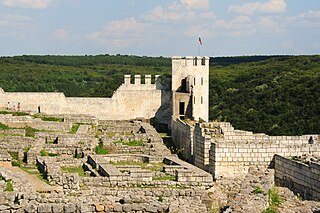
The Shumen fortress is an archaeological site overlooking the city of Shumen in north-eastern Bulgaria.

Ravna Monastery was a literary center of the Preslav Literary School during the 9th and 10th centuries in the north-eastern part of the Bulgarian Empire. It is located near the village of Ravna, at 11 km northwest of the town of Provadia, Varna Province, north-eastern Bulgaria. It was studied in the 1980s.